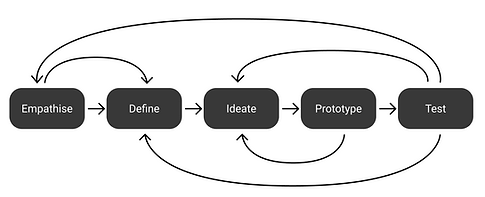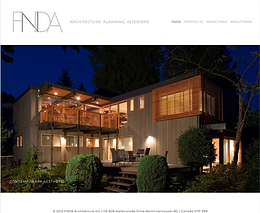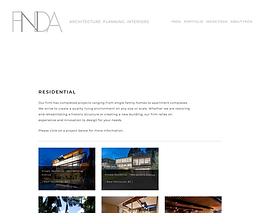FNDA
ARCHITECTURE
FNDA Architecture is lacking the ability to showcase their award-winning projects and are in deep need of a website rehabilitation. This project covers the beginning stages of industry research to the final hand-off with the client.


Project Type:
Timeline:
Role:
Client
7 Weeks
Product/UX/UI Designer
Skills:
Figma (Wireframing & Prototype)
User Interviews and Usability Testing
User Flows and Personas
Information Architecture
Journey Map
Business Model
Property Brothers Designers
The Challenge: The award-winning firm, FNDA Architecture, is globally appraised for their cultural designs across the world, however they do not have a website that properly represents their prestigious work. Building an online audience from scratch to market the large work portfolio and custom products the firm has to offer.
The Goal: Growing the client list for the firm by neatly and creatively expressing the firm's work portfolio plus adding a space for the sale of their custom products. The website must accurately display the contemporary-modern design approach of the firm.
The design thinking approach will be used to complete this project as the team begins completing design, industry, and firm research before beginning the product design. The product will then be tested and reviewed with the client for 3 iterations until the final product is complete.




Home Inspection
With limited time on this project, a competitive analysis, user interview, user testing, and a platform analysis was completed to determine the best direction to head with the design of this website.
Competitive Analysis
The competitive market research observed eight architecture, interior design, and furniture stores that offer similar services to FNDA. From this analysis, I was able to determine the content similar firms were pushing to viewers, while also noting similar information architectures so that the user flow on the FNDA product will be simple and recognizable.
Heuristic Analysis
Language used on the original website was inconsistent and unclear to users what content titles were actually providing. UI elements across the website were not clear to the user, often leading users to not visit pages and get the information they desire.
User Interviews
Six (6) potential users were interviewed to answer the project exploratory questions. Purchasing habits were examined to determine the products FNDA should begin selling and how they should sell them.

-
Users were more hesitant to purchase large, expensive products due to accuracy issues, brand trust, delivery costs, and return process.
-
Users reported social media to be a large influence on their own design styles, inspiration.
-
Users want to instantly understand the services offered by the firm as well as their specialties and best work.
-
Users want to understand the firm's design process to determine if the firm is right for them to hire.
Understanding the Business Needs
With limited time on this project, a competitive analysis, user interview, user testing, and a platform analysis was completed to determine the best direction to head with the design of this website.
Love It or List It!
Now that I have a clear understanding of the business's needs and their user's needs, I can begin to ideate my ideas in low fidelity wireframes to present to the client for the first round of feedback. With that feedback, I created a mid to high fidelity wireframe for further feedback.
The FNDA team is a busy firm and throughout this design process, it was difficult to receive proper feedback and discuss reasoning for design from FNDA, thus many design decisions came from the research conducted in the early phases. The FNDA team struggled to see the vision of the project through the low and mid fidelity wireframes and left it up to the design team to make the executive decisions during the short duration of the project.
Extreme Makeover:
Website Edition
With the minimal feedback received from the client, I created a final product to hand-off to the client based on user research and common industry practices. The final product was transferred to Squarespace as requested and a usability testing was conducted by having four potential users complete simple tasks. I made sure all of the client and user's problems discovered in the research were solved in the final product.
The firm's colour branding was updated to make the website memorable with a bold and passionate red that the firm was interested in eventually incorporating.





Problems
1. Clients would contact firm for extra information and questions that would normally cost them.
2. A store must be available to sell products.
3. The firm must show they are active and up-to-date in the design industry.
4. The firm would like to improve their online branding with new and past clients.
5. FNDA website does not offer any contact information resulting in zero clients being recruited from the website.
6. User flows have dead-ends and do not allow the user to backtrack their flow without starting over.
Solutions
1. Clients can now schedule an appointment with the firm at a cost from the consulting or contact page.
2. A store was set up with place holders for when the firm chooses to begin selling their products.
3. A section covering their current projects has been created.
4. A new colour scheme, current projects, and newsletter (increase client list) feature have been added.
5. A contact page has been added with FNDA contact information. Users can easily send an email with a form or book an appointment.
6. Suggested pages are provided to the user along with a secondary navigation for pages that have many subpages.
"You were able to take the research and little input from us and run with it to create a great product"
-Farouk Noormohamed, FNDA Chair
Project Learnings
After completing my first start to finish UX project, I learned multiple lessons working with clients and design thinking.
-
Research is the best guide for design. It is best to design according to what your client wants, but research is there for a reason. We must understand what is important information, priority user flows, etc. and integrate that into the client's design wishes to provide a great UX experience.
-
Listening to reason is the best direction for design. Working alongside a team of designers giving their input into your design can be challenging, however you often make design mistakes that you are unable to catch. Having reasoning for your design decisions, supported by research, will create the best product. All criticism and feedback must be accounted for in order to discover design decisions that do not have a strong supporting reason.
-
Be prepared to know your's and the client's next steps. Clients will have a different schedule than you and your work may not be their top priority. It is important to make sure you provide everyone with the information they need so everyone can begin working.

